Earthen Architecture: Characteristics and Implementation, Case Study of Earthen Building in Jordan
Diala I Atiyat*
Department architecture, Alexandria university -collage of engineering, Egypt
Submission: July 19, 2017; Published: September 18, 2017
*Corresponding author: Diala I Atiyat, Department architecture, Alexandria university-collage of engineering, Egypt, Tel: 962-653-55000; Email: archdiala@yahoo.com
How to cite this article: Diala I A. Earthen Architecture: Characteristics and Implementation, Case Study of Earthen Building in Jordan. Civil Eng Res J. 2017; 2(1): 555577. DOI: 10.19080/CERJ.2017.02.555577
Summary
This paper approaches earth as an effective and useful building material with various characteristics that separate it from other materials used in construction. Earth is amongst the first known materials to man that had been used in building. This material has many notable and distinguished properties together with some flaws and imperfections that must be assessed, studied and reduced to enable working with it. Methods have varied when it came to using this material in construction both in the past and the present, which depended mainly on environmental determinants including climate, soil quality, and obtainable materials in addition to the nature of available expertise. Nowadays, earth has received ample attention acting as a solution for different issues in industrial and developing worlds alike, where the industrial world suffers from pollution and energy problems and the developing world suffers from housing and unemployment problems. The main objective of this paper is to go over the properties of earth and its application in the new field of architecture in Jordan, while pinpointing the main aspects to develop this material to make possible using it to the highest degree conceivable in present and future architecture.
Keywords: Earth-clay-earthbag material; Feynan Eco-lodge; Al-Jawasreh village; Old jafr School
Introduction
Earth is considered one of the oldest materials man known and used in construction for approximately 10,000 years. Nothing is more prevalent than inexhaustible and versatile materials such as earth, clay and soil that have been used to build several prominent cultural landmarks, such as the pyramids of the sun and moon in Teotihuacan Mexico, churches and mansions in the old city of Havana Cuba, Alhambra Palace in Spain, along with Shibam in Yemen, which is often referred to as Manhattan of the Arabian Peninsula. Many cities in the Arab World were built using soil (earth) including Marrakesh in Morocco and Aleppo in Syria. Hasan Fathi comments on this topic that sustainable architecture and earthen houses contain the services needed in our current time where no clash occur between the present and the past, which was made clear 40 years ago Fathi [1]. (The method to achieve rationing and lessening the rate of pollutants in houses built from natural materials).
Research Problem
Earth has been a primary and indispensable companion to man throughout the ages, being a provider of a safe and comfortable sanctuary for him. It is also one of the materials that respond to environmental data with its climatic and social aspects, where man is free to shape and put together in the way he sees fit in order to express his needs and emotions. Studying earthen architecture and keeping it is among the essential matters regarding preserving heritage sites, after all, earthen architecture provides appealing and exquisite resolutions for the environmentally sensitive buildings in the modern context. In fact, earth is often locally available, and its use minimizes the need to transport heavy building materials.
Methodology
The descriptive analytical approach will be adopted coupled with the use of a local case study in the Hashemite Kingdom of Jordan to depict the importance of earth in construction as a material with certain features that help in achieving sustainable goals on architectural and social domains alike. Societies fashion most of the aspects related to earthen architecture with the contribution of buildings,2019; users and under the supervision of the most renowned and recognized builders. Many illustrations of these structural, communal and democratic practices exist in America, Africa and Asia. There are buildings such as mosques in Timbuktu that the community preserved for generations, and in Haiti, groups of families build each other's houses, which are proven to adapt particularly to earthquake conditions.
Earth as a building material
Earth has been the most common and obtainable material to the primitive man, this material has intrigued man and caught his attention, it was the first raw material ever used in building houses. Certainly, earth-soil is the natural environment and medium that embraced the human. Earth- soil has provided for human being all that is needed whether it was food or shelter, it offered the primitive man power, trust and comfort during difficult times when he resorted for its caves and holes. The human bonded and interacted with earth throughout history, and hence, the idea of using earth as a building material was originated. This material that is considered close to man is easily shaped to meet all of his life needs, shelter being the first need Kottayam [2].
Earthen architecture
As a result of studying and examining the history of human urbanism over different eras, it can be established that earthen architecture has been the most prevalent type of architecture through history and in different continents, thus, it is the type of architecture that dominate the entire world. Its initial characteristics, nevertheless, emerged and evolved in oriental civilizations according to all scientific data including archaeological excavations, accounts and historical observations in addition to anthropology. And it remains the most common type of sustainable architecture, the least expensive and the most convenient to create in the world. Consequently, it definitely became the most prevailing humanitarian architectural heritage. According to the statistics of the United Nation, one-third of the world's population still live in houses built from earth, or earth- soil comprises a basic element in the building material Kassel[3].
Earthen architecture presents itself vigorously as one of the main solutions for housing problem together with sustainable development in our modern world, and as one of the primary practical aspects that link architectural heritage with modern life. Earthen architecture has become one of the best approaches to unravel the housing dilemma, mitigate the problems associated with the manufacturing of building materials and reducing the environmental pollution Jerome et al. [4]. Relying on soil as a primary building material, and accordingly, choosing the field of earthen architecture as a part of the promising solutions to overcome the issues of rural housing in the outskirts of small towns, is a necessary choice for the following reasons: Azab [5]
- The history of earthen architecture that dates back to old times and its ability to keep up with the different stages of human societies are but a proof of its capability to engage in the various economic and social activities of humans throughout different eras.
- Earthen architecture is an organic architecture that shares a strong bond with the environment, it responds to the enforced climatic conditions and it achieves a considerable amount of comfort and satisfaction since it provides high heat insulation which increases the frugality of cost, usage and saving energy for cooling and heating.
- Earthen architecture is environmentally clean, it does not cause pollution associated with construction, since using earth as a building material does not require the use of polluting energy. Also, the disposal of the products of old earth used in construction does not pollute agricultural fields, these products can be recycled into soils that are suitable for agriculture or they can be reused as a building material Satprem Satprem Maïni [6].
- Earthen architecture provides the needs of most social classes, it is a housing architecture in both cities and rural areas, it is suitable for modest housings as well as mansions in addition to public facilities such as mosques, schools and warehouses.
- The ease of using earth and the fact that it is not associated with special techniques encourages public participation in the building process, which contributes in providing convenient job opportunities for the local community.
- Using earth as a building material is economic compared to other building materials, its cost suit the individual income in limited income communities, it reduces the severity of importing the remaining building materials and it contributes in lowering their costs.
- The tendency to build using local clay materials is one of the most important aspects of sustainable development in many countries across the world including India, Australia and many others.
Advantages of using earth in buildings in local architecture in jordan and the arab world; characteristics of earth buildings: Kottayam [2]
- Preserving trees and the environment since there is no need for either wood or coal to make bricks.
- Supporting the local economy by providing job opportunities for residents and using traditional materials.
- Providing complete insulation for heat and cooling which preserves energy.
- Offering convenient and inexpensive housing with the possibility of using earth in building luxurious houses.
- It possesses properties that are compatible with modern technologies (preserves heat and cooling during summer).
- It is easy to build using earth.
- The different ways that can be employed to use earth in buildings.
- Saving costs in transportation and the ease of the process.
- Limiting the unemployment of inexperienced workers.
Disadvantages of using earth in buildings: [2]
- Earth has low resistance to water effect.
- Volumetric change of earth products.
- The surfaces' tendency to erosion due to different environmental elements (such as wind and rain), which contributes in weakening the solidity of this material, and the weakness of the attachment between earth and other materials such as wood, where this weakness can cause problems when implementing openings ( windows and doors).
- Earth is a home for rodents and insects.
Methods of using earth in buildings: Emery [7]
There are a variety of methods where earth can be used in all elements of the building:
- Complete excavation of the building in the soil.
- Earth walls.
- Custom molds as in the case of soil compaction method.
- Different kinds of bricks (earthbrick).
3.6. Most prominent methods of building using earth:
- A course of earth bricks
- Compressed soil such as Marrakesh, Morocco.
- Using modern machines in manufacturing brick in commercial quantities.
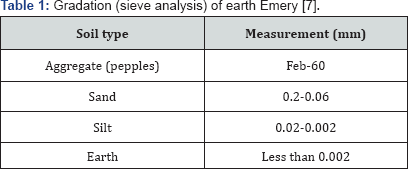
Earth is found freely in nature, it is usually found in low- lying and agricultural areas or at the sides of valleys and in water dam reservoirs. The best types of soil to be used in construction contain 25-30% earth and silt and 70-75% sand and gravel, and in any case the total of earth and silt should not exceed 40%. The earth mixture must be prepared carefully to ensure getting good quality brick or mortar, and the gradation of the mixture ought to be integrated and continuous. According to the British Standards soil is categorized depending on gradation (sieve analysis) based on the following Table 1.
Soil type can be determined through several quick field tests, these tests help in deciding whether the soil is suitable for construction purposes. Among these tests: Berge [8]
- Wash test: the hands are washed with wet soil, if the soil was sandy the hands will become clean, if the soil was silty it will appear as powder, and in case it was earthdy it will give a soapy feeling and its remains cannot be easily washed.
- Determining density through precipitation: a graduated beaker is filled with soil and water with a ratio: 25% soil and 75% water. Shake the beaker well and let it precipitate, after an hour shake it again, in 45 minutes you'll find that the precipitated soil is arranged from bottom to top in the following order: aggregate, sand, silt, clay. The approximate ratios of volume of the components can then be calculated. Jaquin [9]
- Deflation (Alcock Test): a mold is made with dimensions 4*4*60 cm, and is filled with the sample that must be mixed with water to the degree of saturation (moisture content optimum), taking into account filling and leveling the corners and the surface well. The mold is then placed out in the sun for duration of three days or in the shade for seven days. The hardened soil is then moved to one of the corners of the mold, and the space between the sample and the mold corners is measured Emery [7].

Hence, the appropriate test is necessary to prepare mortar or good quality brick. The ratios of formation of the soil used in construction must be according to the following table and the percentage of water in the mixture ranging between 16% to 20% Table 2.
Applications of Earthen Architecture in Jordan
There are several examples of earthen architecture, and using earth as a basic building material. Two examples will be selected; one is relatively old and the other is modern, for the most prominent applications in Jordan, where they are considered to be successful examples.
A school in Al Jafr
It is a beautiful architectural compound built from earth brick, topped with 8 earth domes. It contains 8 rooms, distributed in a way that achieves visual balance. All rooms have doors that overlook the open yard, which mediates the building.
The windows are distributed on both the front and side walls of the building. There is a services extension located at the center of the building. The yard is divided by a wall, where each four rooms have its own yard. The western yard contains a well in addition to a water basin. The full length of the building is 25 meters, with a width of 16 meters and height of 6 meters, the dimensions of each room are 4x4 meters. The compound was built in 1959 by the architect Yassin Saleh Swairki, the building has been used primarily as a housing and training center for Al Jafr agricultural project, as a part of the Bedouin Settlement projects in the early sixties. The building was used to manage an agricultural project (afforestation and training) with an area of 45 dunums, divided into units with an area of 5 dunums per unit, each unit attached to a housing block. In 1964, the building was used as a mixed school.
Architecturally, the compound was built from earth including domes, no wood or tree branches has been used. It represents an architectural style that was invented by the civilizations of Mesopotamia and East Mediterranean desert. In Jordan these domes have appeared in the area of the Jordan Valley including North Shuana, Ghor Al Safi in addition to Jarf Al Daraweesh and Al Jafr Zmankom [10].
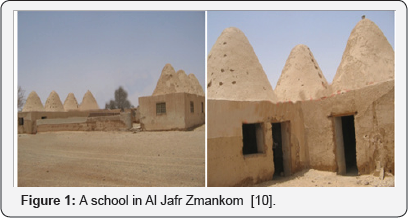
The Earth dome is suitable for the hot environment, it provides alternate distribution of shadow and light, where a part of the dome is in the shade while the other part is exposed to the sun, and hence, the hot and cold air moves interchangeably, and it is renewed through the openings in an elevated space due to the dome (at the height of 6 meters)Figure 1.
Qusayr Al-Jawasreh
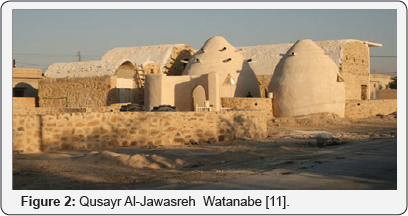
QUSAYR AL-JAWASREH is a community center for the Al- Jawasreh Society led by a group of local ladies, located in South Shounah near the Dead Sea in Jordan. It is a public facility open to the local community, where educational and vocational programs are provided. It has three architectural components: Jordan's traditional stone and earth building, modern reinforced concrete, and earthbag building which draws attention as ecological architecture (Figure 2). These three components are integrated into a "jewelry box" which reminds the people of old feelings and new dreams. Thick stone walls have high insulation efficiency. Reinforced concrete enables creative design of roof and large and bright opening section. Earth-bag building can be made by anybody with the earth, and it is absolutely eco-friendly and strong Watanabe [11] (Figure 3,4).
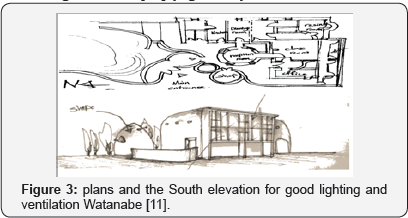

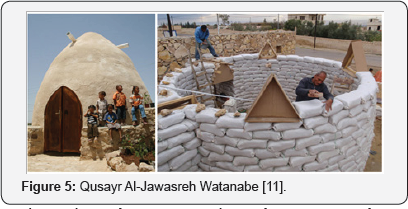
A passive solar system using solar energy makes a comfortable environment inside the building, cool in summer and warm in winter. A large opening section in the south area keeps whole rooms well-lit throughout the year Watanabe [11]. Based on the secret of Japanese garden, "dray garden style" (karesansui), a mysterious garden is designed in the south area by using modern techniques of environmental engineering. Depressions/Dips in the center carve memories of people who dig the earth to fill the earth-bags. Deciduous trees signify the change of seasons, protect the building from strong sunshine in summer, and allow the sun through in winter. Colorful flowers and herbs bloom in pots set in the garden. At QUSAYR AL-JAWASREH you can get traditional hand crafts made by the ladies of Al-Jawasreh village. It is a design of the traditional stone -earth bags building, leading toward the future Figure 5.
Feynan Eco-lodge
Feynan Eco-lodge sits on the lower entrance of the Dana Biosphere Reserve in Wadi Araba. It has an access from the lowest African Ecosystem which makes the ecology of the place even more interesting. Sited in the lower end of the Dana Reserve, the lodge was built in the wadi (bed) where a previous campsite for The Natural Resource Authority once existed in the 1960's. The project was intended to use the exact footprint of the old campsite, so as not to extend the already-interrupted area of intervention.
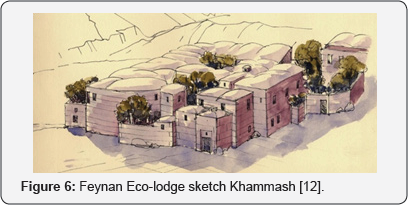
"I wanted a very humble place where people can retire like a monastery, a place where monks stay. I was highly inspired by the poor and basic Coptic monasteries in Egypt which I once visited." -Ammar Khammash Figure 6.
The client (i.e. RSCN) asked for a very basic and minimalist building. Their main aim was to spend their resources on training, operating and managing the wildlife in the reserve. So, the building was done in a very strict low-cost policy Khammash [12]. Just like writing the story, the experience should be narrated throughout the project. First, the escape from Amman. Then, after a long ride in nowhere the visitors enter the valley. And then, it boils down to asking the right questions of: what would the visitors eat; how would they spend their time; where would they sleep; what would they smell in the morning; what would they hear? By responding to those questions, the story of that place was created. The creation of the narrative even included the creation of the meal to be served. It had to be a minimal vegetarian meal, and so the Jordanian Mansaf yoghurt pasta was invented. That later helped in determining the requirements and size of the kitchen.
If we are to take the metaphor further, part of a Monk’s prayer is living on bread alone. In an attempt to prove how the city spoils the spirit, the rooms were designed to be too minimal, with no televisions, radios or electricity. Batteries die in the first day and somehow the visitor ends up being forced to give up those things and experience the deprivation just like monks (Figure 7). The light penetrates the courtyard openings which manipulate the natural sun light just like a self-sculpting instrument that plays the moving light across the different hours of the day. The passageway in the interior of the building carries resonances from the old souqs of Damascus and Aleppo. It connects the light masses of the different courtyards together to form a passive cooling system, especially when the wind blows right into the passageway, a wind chimney is createdFigure 8.
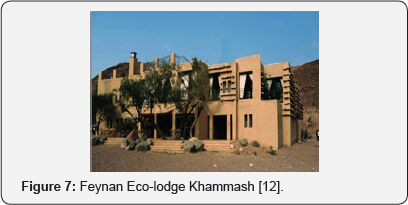
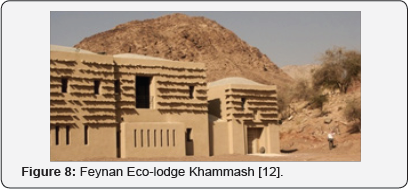
Just like a typical Jordanian Fellahi peasant house built in the 19th century in which women used to mold the furniture from earth-based plaster, our office adopted the same monolithic approach when designing the interior spaces, rendering a wall into a desk, a bed or a sofa. The architecture of the exterior extends to the interior, creating a vivid coherence between the outside narrative and the inside. The mono-material language of the space, reminiscing a womb or a shell, makes it very relaxing for the escaping visitor. The typical room in Feynan Eco-lodge is made out of nude walls from sand and cement, cotton white
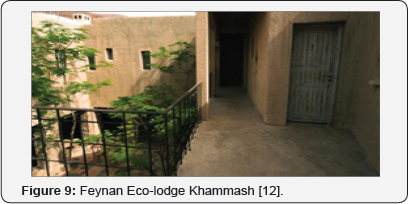
Learning from sandstone geology in arid environments like Petra Mountains, which is made from one kind of stone with no present green cover, light becomes traceable as it moves and becomes the only player on stage. The monolithic spaces push built reality to conceive light as a tangible mass Khammash [1] (Figure 9). Stone chips were used as sun-breakers in the southern and western elevations; a technique widely used in Asir in Yemen and some parts in Saudi Arabia. In addition to the stone chips sculpting value, they were valuable in forming a climate control tool. In the summer, the stones shade the walls from the vertical sun; as the sun moves, the elevation changes dynamically over the day. During the winter season, the sun is lower and the shade is shallower, thus heat is retained in the walls warming the building's interior (Figure 10).
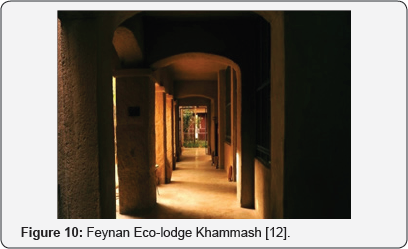
Just as most of the Jordanian poor families use concrete blocks as the main unit of building, it was used in the construction of Feynan Eco-lodge walls. The architecture of the Jordanian countryside and poor Jordanian families, using this material, is mostly boring but it is solid and does not need maintenance. The worst thing about using such material is the poor insulation, to overcome that in the lodge: a double layer of blocks were used with an air gap in the middle Khammash [12]. Since most of the heat escapes through the roofs, it was the biggest climate control challenge. To overcome heat loss, roofs where made from two layers of Ferro-cement sandwiching straw bales in- between to ensure low thermal bridging. The very thin inflated organic domes do not follow any particular geometry; they were done spontaneously from 3-4cm of plastered chicken wire. The protruded and bulging domes face the sun from one side, and shade the other side, another climate control strategy used in the project.
Conclusion
The importance of supporting and strengthening earthen architecture due to its capability to fight poverty and protect the environment. Earth does not only represent the land on which we stand, it represents the necessary structure to build our future. Therefore, it can be reasserted the gravity of neglecting this architectural style which is common locally and worldwide, taking into account its content of aesthetic aspects and artistic possibilities capable of succession, interaction and implementation in our communities, especially the rural ones.
Earth (basically soil) managed to survive long enough, and to endure hardships, due to its construction durability and balance, and the cohesion of its architectural and construction design, which reflects an advanced knowledge and professional level of the architect and the worker. The plains of Mesopotamia as well as the countries surrounding Jordan are filled with historical experience connected to this type of architecture. Thus, the continued use of earth as a basic building material in the region, is but a proof of its continued validity for today’s architecture, especially in rural areas, with its different functional forms, since it takes into account the natural and social circumstances, and preserves the residents' cultural specificity, and it achieves material and spiritual communication with the past, it gives a distinguished character on the architectural form that is characterized by originality and uniqueness.
The possibilities of improving the specifications of soil-earth as a building material are promising, and have been proved worldwide and its ability to improve the structural performance have been confirmed, whether by increasing its resistance of by providing ways of protection and insulation, which ensure its durability and continuance. Furthermore, improving the idea of urban design of residential earth compounds in a way that assists in creating an urban environment that is large and cooperative, on one hand it multiply the process of protection and insulation within harsh climatic conditions, and on the other hand it establishes independent social relationships.
References
- Fathi H (1996) the architecture and the environment, a series of writings, Dar Almaaref, Cairo-Egypt.
- Kottayam K (2013) Earthen Architecture Sruthi G S Department of Applied Mechanics and Hydraulics, National Institute of Technology Karnataka, Karnataka, India. Conference on Energy and Environment- (ICEE 2013) On 12th to 14th December Organized by Department of Civil Engineering and Mechanical Engineering of Rajiv Gandhi Institute of Technology, India.
- Kassel (2006) Gernot Minke Gernot Minke Building with Earth Design and Technology of a Sustainable Architecture Birkhäuser Publishers, Berlin / Germany
- Jerome, München P, Saur KG (2005) Earthen Architecture: Yemeni Mudbrick at risk. Heritage at risk 2004/2005: ICOMOS world report on monuments and sites in danger eng, p. 263-264.
- Azab, Salem T (2002) Earth brick building experiences. first-Engineering Conference Klahalengh-University of Aden, Aden, Yemen.
- Satprem M (2005) Earthen architecture for sustainable habitat and compressed stabilised earth block technology-india Heritage Preservation Program-Lecture earthen architecture and construction techniques with soil compressed
- Emery, Virgignia L (2011) Earth-Brick Architecture. In: Willeke W (Edn.), UCLA Encyclupedia of Egptology, Los Angeles, USA.
- Berge B (2009) The ecology of building materials (2nd Edn.), Architectural Press, Elsevier Science, Amsterdam, Netherlands.
- Jaquin PA (2008) Analysis of historic rammed earth construction. PhD thesis.Durham University, UK.
- Zmankom (2011) The oldest school built of clay domes topped 8 earth in Jafr.
- Watanabe K (2016) Community Center for Al-Jawasreh Village.
- Khammash A (2002) Feynan Eco-lodge, Dana Biosphere Reserve, Jordan.






























